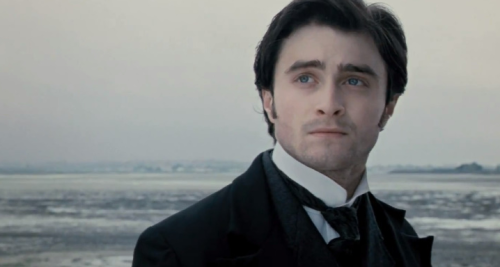Gothic horror brings to mind Victorian period, where people were obsessed with death, what came after, and how to be sure that their loved ones were in a safer place. Queen Victoria's reign made the mourning period a culture - and thus a variety of ghost stories were born. Susan Hill's The Woman In Black continues this tradition, and the story carries such weight that it's been made into several different formats: a radio program, a theater play, and a british film. Most recently it was adapted by the newly reopened Hammer Studios for a theatrical film starring Daniel Radcliffe. Here I'll talk about the adaptation of book to film, and compare what works, and what doesn't. There will be some spoilers, as I'll have to cite specific scenes and passages for comparisons, so read on with that warning in mind.
There are several things that the film and book hold in common, and that is the main aspects of the story: a man named Arthur Kipps travels to Crythin Gifford to put into order the left over documents of one Alice Drablow, owner of Eel Marsh House. From here, the tone of both the film and the book differentiate wildly - in the movie, Arthur is a widower who is caring for a young son who he cannot seem to rise above his depression for. He is sent to Eel Marsh House as a last chance to keep his job, and thus maintain a roof over his son's head - this Arthur is a morose, withdrawn person who sees very litte worthwhile to continue living for. Contrasting this is the Arthur of Hill's story: engaged to be married, he's doing well in the firm and is sent to Eel Marsh House as a sort of test to prove his worth.
And then there is the question of the title character herself, The Woman In Black. Her backstory remains the same in both the book and the film, and thus I will leave that for the reader/viewer to discover; what differs are her actions. Generally, though, when there is a sighting of the woman, one thing is certain: a child has died through violent circumstance. In the book, there is only one example of this, which comes at the very end (in a somewhat predictable manner), in a separate area other than Crythin Gifford. It certainly shows that the woman's power extends beyond her home and the surrounding area, even so far as into a widely populated city as London. But during the bulk of the book, the house is the perpetrator, the thing that causes the terrifying sounds that drive Arthur toward the brink.
The film takes a different route entirely - we see the deaths of several children, all incredibly violent. But they're spread out, used as punctuation on the tail ends of scenes to prove that the woman in black is not just a figment of anyone's imagination. Or is she? The interesting part is that the only person who sees her (at least within the span of the movie itself) is Arthur. Since he is depressed, and thus not altogether in his right mind, he is an unreliable narrator. While the film does eventually relent that there is something more after death, throughout the body of it we can be left questioning whether Arthur's mind is playing tricks on him because he desperately wants to know whether or not his wife still exists on some plane. Threads of spiritualism are woven throughout the film, another facet of the time period where seances and mediums were fashionable; one character is even possessed by the spirit of her dead son in order to warn Arthur.
I do wish that they'd played with this idea a little more; it's very Edgar Allan Poe, where in a few of his stories the narrators are unreliable due to drug abuse, alcohol, or instability of the mind due to depression or other mentall illnesses. It makes for a more gripping tale when one isn't sure they can trust the source of their information. But it's this aspect of the film that made me enjoy it more than the book - the only scene in the book that truly held any tension for me was when Arthur runs into the causeway after hearing a child screaming in the mists. He becomes lost and disoriented, unable to find his way until he runs straight back to Eel Marsh House, and there has to wait for Kerwick to find him. This scene is brought to life in the film, but it didn't hold as much terror for me as it did in the book. However, the woman in black never seemed as much of a terrifying presence in the book as she did in the film; since we are given more examples of her power, she becomes more than just a lurking shadow in the background.
So, in the end, I believe that the newly released film, now playing in theaters, is actually a better use of the material that Susan Hill first created in 1983. Of course, without her book we wouldn't have the film to begin with, and this isn't to say that the ideas within her story don't have some power - it's a very quick and pleasurable read, with some fantastic descriptions of a haunted house. I sincerely reccommend both the book and the film, but for myself, the film really took the ideas to a new height.





No comments:
Post a Comment